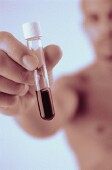Free, bioavailable testosterone levels independently tied to ED risk
TUESDAY, April 14, 2015 (HealthDay News) — High levels of free testosterone (FT) and bioavailable testosterone (BT), and low levels of sex hormone-binding globulin (SHBG), are tied to a decreased risk of erectile dysfunction (ED) in young men, according to a study published online March 20 in the Journal of Sexual Medicine.
Yawen Luo, from Guangxi Medical University in Nanning, China, and colleagues evaluated the association between sex hormones and ED in 733 Chinese men participating in Fangchenggang Area Males Health and Examination Survey (September 2009 to December 2009).
The researchers observed a decreased risk of ED among men in the highest tertile of FT (relative ratio [RR], 0.21) and the lowest tertile of SHBG (RR, 0.38). A decreased risk was seen in young men (aged 21 to 40 years) with the increase of FT and BT (adjusted RR, 0.78 and 0.75, respectively). There was an inverse association noted between ED and total testosterone (RR, 0.89), after adjusting for SHBG. SHBG remained positively associated with ED after further adjusting for total testosterone (RR, 1.04). Highest risk of ED was seen in men with both low FT and high SHBG (adjusted RR, 4.61).
“Further studies are urgently needed to clarify the molecular mechanisms of testosterone acting on ED,” the authors write.
Copyright © 2015 HealthDay. All rights reserved.








